Spatiotemporal Variation and Driving Factors of Carbon Sequestration Rate in Terrestrial Ecosystems of Ningxia, China
Abstract
1. Introduction
2. Materials and Methods
2.1. Study Area
2.2. Data Sources and Preprocessing
2.2.1. Field Survey Data
2.2.2. Multimodal Datasets
2.3. Remote Sensing Inversion Methods for Carbon Density
2.4. Carbon Sequestration Rate Calculation
2.5. Trend Slope Analysis
2.6. Geographical Detector
3. Results
3.1. Carbon Density Inversion Result Accuracy Verification
3.2. Spatial Variation Characteristics of CSR in Ningxia
3.3. Temporal Changes in CSR (2001–2023)
3.4. Influence of Land Cover Types on Ecosystem CSR
3.5. Influencing Factors on CSR in Ningxia
4. Discussion
4.1. Uncertainty Analysis
4.2. Comparison with Other MODIS Products
4.3. Spatial Heterogeneity of CSR in Ningxia and Its Driving Factors
5. Conclusions
- (1)
- During 2001–2023, the CSR of Ningxia’s ecosystems exhibited a spatial distribution characterized by higher values in the south and lower values in the north. The mean CSR was 21.95 gC·m⁻2, with an overall fluctuating upward trend and a growth rate of 0.53 gC·m⁻2·a⁻1.
- (2)
- The CSR means significantly differ across different ecological regions. The Liupan Mountain water erosion area had the highest carbon sequestration capacity with a mean of 46.51 gC·m⁻2, while the Helan Mountain water erosion zone had the lowest CSR mean of 11.34 gC·m⁻2. The carbon sequestration rate in the Water Erosion Area of Loess Hilly and Gully Residual Tableland showed the most significant increase, with an annual growth rate of 1.16 gC·m⁻2·a⁻1.
- (3)
- For land use types with unchanged coverage, the carbon sequestration capacity is ranked as forest > cropland > grassland > barren, while the enhancement capacity is ranked as cropland > forest > grassland > barren. In terms of land-use change types, the CSR ranking is as follows: G-F > C-Fg > B-Fg. The enhancement capacity ranking is C-Fg > G-F > B-Fg.
- (4)
- Among the individual influencing factors, the NDVI is the primary driver of the spatiotemporal dynamics of the CSR in Ningxia’s ecosystems. However, the two-factor interaction between the EVI and Bulk Density provides a more significant explanatory power for the CSR.
Author Contributions
Funding
Data Availability Statement
Conflicts of Interest
References
- Lv, Y.; Zhang, L.; Li, P.; He, H.; Ren, X.; Zhang, M. Ecological Restoration Projects Enhanced Terrestrial Carbon Sequestration in the Karst Region of Southwest China. Front. Ecol. Evol. 2023, 11, 1179608. [Google Scholar] [CrossRef]
- Bu, X.; Cui, D.; Dong, S.; Mi, W.; Li, Y.; Feng, Y. Effects of Wetland Restoration and Conservation Projects on Soil Carbon Sequestration in the Ningxia Basin of the Yellow River in China from 2000 to 2015. Sustainability 2020, 12, 10284. [Google Scholar] [CrossRef]
- Niu, Y.; Li, Y.; Liu, W.; Wang, X.; Chen, Y. Effects of Environmental Factors on the Carbon Fluxes of Semi-Fixed Sandy Land Recovering from Degradation. Front. Ecol. Evol. 2023, 11, 1178660. [Google Scholar] [CrossRef]
- Wang, M.; Hu, Z.; Wang, X.; Li, X.; Wang, Y.; Liu, H.; Han, C.; Cai, J.; Zhao, W. Spatio-Temporal Variation of Carbon Sources and Sinks in the Loess Plateau under Different Climatic Conditions and Land Use Types. Forests 2023, 14, 1640. [Google Scholar] [CrossRef]
- Khodakarami, L.; Pourmanafi, S.; Soffianian, A.R.; Lotfi, A. Modeling spatial distribution of carbon sequestration, CO2 absorption, and O2 production in an urban area: Integrating ground-based data, remote sensing technique, and GWR model. Earth Space Sci. 2022, 9, e2022EA002261. [Google Scholar] [CrossRef]
- Misiura, K.; Dąbrowska-Zielińska, K.; Gurdak, R.; Grzybowski, P.; Kluczek, M. CO2 Modelling from Eddy Covariance Measurements for Biebrza Wetlands. In Proceedings of the IEEE International Geoscience and Remote Sensing Symposium (IGARSS), Brussels, Belgium, 11–16 July 2021; p. 9554112. [Google Scholar] [CrossRef]
- Goulden, M.L.; Munger, J.W.; Fan, S.M.; Daube, B.C.; Wofsy, S.C. Measurements of carbon sequestration by long-term eddy covariance: Methods and a critical evaluation of accuracy. Glob. Chang. Biol. 1996, 2, 169–182. [Google Scholar] [CrossRef]
- Nathaniel, J.; Klein, L.; Watson, C.; Nyirjesy, G.; Albrecht, C. Above Ground Carbon Biomass Estimate with Physics-Informed Deep Network. In Proceedings of the IGARSS 2023—2023 IEEE International Geoscience and Remote Sensing Symposium, Pasadena, CA, USA, 16–21 July 2023. [Google Scholar] [CrossRef]
- Abbas, S.; Wong, M.S.; Wu, J.; Shahzad, N.; Muhammad Irteza, S. Approaches of Satellite Remote Sensing for the Assessment of Above-Ground Biomass across Tropical Forests: Pan-tropical to National Scales. Remote Sens. 2020, 12, 3351. [Google Scholar] [CrossRef]
- Tripathi, S.; Setia, R.; Ghosh, T.; Uniyal, P.; Kumar, A. Evaluation of Spectral Indices to Monitor the Vegetation Species in a Sanctuary for Carbon Sequestration in Soils Using Landsat Satellite Remote Sensing. Int. J. Environ. Earth Sci. 2022, 10, 357–365. [Google Scholar] [CrossRef]
- Feng, X.; Fu, B.; Lu, N.; Zeng, Y.; Wu, B. How Ecological Restoration Alters Ecosystem Services: An Analysis of Carbon Sequestration in China’s Loess Plateau. Sci. Rep. 2013, 3, 2846. [Google Scholar] [CrossRef] [PubMed]
- Huang, L.; Liu, J.; Shao, Q.; Xu, X. Carbon Sequestration by Forestation across China: Past, Present, and Future. Renew. Sustain. Energy Rev. 2012, 16, 1291–1299. [Google Scholar] [CrossRef]
- Sandi, S.; Rodriguez, J.; Saco, P.; Saintilan, N.; Riccardi, G. Accelerated Sea-Level Rise Limits Vegetation Capacity to Sequester Soil Carbon in Coastal Wetlands. Earth’s Future 2021, 9, e2020EF001901. [Google Scholar] [CrossRef]
- Aubrey, D.; Blake, J.; Zarnoch, S. From Farms to Forests: Landscape Carbon Balance after 50 Years of Afforestation, Harvesting, and Prescribed Fire. Forests 2019, 10, 760. [Google Scholar] [CrossRef]
- Lal, R. Food Security in a Changing Climate. Ecohydrol. Hydrobiol. 2013, 13, 8–21. [Google Scholar] [CrossRef]
- Mekonnen, Z.; Riley, W.J. Climate Change Will Increase Biomass Proportion of Global Forest Carbon Stocks. Geophys. Res. Lett. 2023, 50, e2023GL104612. [Google Scholar] [CrossRef]
- Moisa, M.B.; Dejene, I.N.; Deribew, K.T.; Gurmessa, M.M.; Gemeda, D.O. Impacts of Forest Cover Change on Carbon Stock, Carbon Emission and Land Surface Temperature in Sor Watershed, Baro Akobo Basin, Western Ethiopia. J. Water Clim. Chang. 2023, 14, 323–334. [Google Scholar] [CrossRef]
- Patton, N.; Lohse, K.; Seyfried, M.; Godsey, S.; Parsons, S. Topographic Controls of Soil Organic Carbon on Soil-Mantled Landscapes. Sci. Rep. 2019, 9, 6397. [Google Scholar] [CrossRef] [PubMed]
- Zhang, M.; He, H.; Zhang, L.; Ren, X.; Wu, X.; Qin, K.; Lv, Y.; Chang, Q.; Xu, Q.; Liu, W.; et al. Increased Forest Coverage Will Induce More Carbon Fixation in Vegetation than in Soil during 2015–2060 in China Based on CMIP6. Environ. Res. Lett. 2022, 17, 105002. [Google Scholar] [CrossRef]
- Sharma, S.; Jain, P.K.; Soloman, P. Carbon Storage Potential of Soil in Diverse Terrestrial Ecosystems. Nature Environ. Pollut. Technol. 2023, 22, 567–578. [Google Scholar] [CrossRef]
- Xu, L.; He, N.; Yu, G. A Dataset of Carbon Density in Chinese Terrestrial Ecosystems (2010s). Sci. Data Bank 2019, 4. [Google Scholar] [CrossRef]
- Beets, P.N.; Kimberley, M.O.; Oliver, G.R.; Pearce, S.H.; Graham, J.D.; Brandon, A. Allometric Equations for Estimating Carbon Stocks in Natural Forest in New Zealand. Forests 2012, 3, 818–839. [Google Scholar] [CrossRef]
- Priya, M.V.; Kalpana, R.; Pazhanivelan, S.; Kumaraperumal, R.; Ragunath, K.; Vanitha, G.; Nihar, A.; Prajesh, P.; Vasumathi, V. Monitoring Vegetation Dynamics Using Multi-Temporal Normalized Difference Vegetation Index (NDVI) and Enhanced Vegetation Index (EVI) Images of Tamil Nadu. J. Appl. Nat. Sci. 2023, 15. [Google Scholar] [CrossRef]
- Camps-Valls, G.; Campos-Taberner, M.; Moreno-Martínez, Á.; Walther, S.; Duveiller, G.; Cescatti, A.; Mahecha, M.; Muñoz-Marí, J.; García-Haro, F.J.; Guanter, L.; et al. Generalization of Vegetation Indices for Monitoring the Terrestrial Biosphere. In Proceedings of the EGU General Assembly Conference Abstracts, Vienna, Austria, 19–30 April 2021. [Google Scholar] [CrossRef]
- Kumar, G.K.; Babu, M.; Mani, A.; Luther, M.; Rao, V. Spatio-Temporal Variation of Vegetation in Godavari Eastern Delta. Curr. J. Appl. Sci. Technol. 2019, 38, 1–13. [Google Scholar] [CrossRef]
- Nejad, M.F.; Zoratipour, A. Assessment of LST and NDMI Indices Using MODIS and Landsat Images in Karun Riparian Forest. J. Forest Sci. 2019, 65, 59–67. [Google Scholar] [CrossRef]
- Lu, Y.; Li, X.; Xin, L.; Song, H.; Wang, X. Mapping the Terraces on the Loess Plateau Based on a Deep Learning-Based Model at 1.89 m Resolution. Sci. Data 2023, 10, 115. [Google Scholar] [CrossRef]
- Wang, Z.; Cheng, M.; Zhang, Y.; Peng, S.; Feng, F. Attributing trend in naturalized streamflow to temporally explicit vegetation change and climate variation in the Yellow River basin of China. Hydrol. Earth Syst. Sci. 2022, 26, 5291–5314. [Google Scholar] [CrossRef]
- Liu, S.; Bond-Lamberty, B.; Hicke, J.A.; Vargas, R.; Zhao, S.; Chen, J.; Edburg, S.L.; Hu, Y.; Liu, J.; McGuir, A.D.; et al. Simulating the Impacts of Disturbances on Forest Carbon Cycling in North America: Processes, Data, Models, and Challenges. J. Geophys. Res. Biogeosci. 2011, 116, G00K08. [Google Scholar] [CrossRef]
- de Blécourt, M.; Corre, M.D.; Paudel, E.; Harrison, R.D.; Brumme, R.; Veldkamp, E. Spatial Variability in Soil Organic Carbon in a Tropical Montane Landscape: Associations between Soil Organic Carbon and Land Use, Soil Properties, Vegetation, and Topography Vary Across Plot to Landscape Scales. Soil 2017, 3, 123–137. [Google Scholar] [CrossRef]
- Belgiu, M.; Drăguţ, L. Random Forest in Remote Sensing: A Review of Applications and Future Directions. ISPRS J. Photogramm. Remote Sens. 2016, 114, 24–31. [Google Scholar] [CrossRef]
- Breiman, L. Random Forests. Mach. Learn. 2001, 45, 5–32. [Google Scholar] [CrossRef]
- Trichakis, I.C.; Nikolos, I.K.; Karatzas, G.P. Artificial Neural Network (ANN) Based Modeling for Karstic Groundwater Level Simulation. Water Resour. Manag. 2011, 25, 1143–1152. Available online: https://link.springer.com/article/10.1007/s11269-010-9628-6 (accessed on 5 November 2023). [CrossRef]
- Pisner, D.A.; Schnyer, D.M. Support Vector Machine. In Machine Learning; Academic Press: Cambridge, MA, USA, 2020; pp. 101–121. [Google Scholar] [CrossRef]
- Fan, J.; Ma, X.; Wu, L.; Zhang, F.; Yu, X.; Zeng, W. Light Gradient Boosting Machine: An Efficient Soft Computing Model for Estimating Daily Reference Evapotranspiration with Local and External Meteorological Data. Agric. Water Manag. 2019, 225, 105758. [Google Scholar] [CrossRef]
- Shi, H.; Wang, P.; Zheng, J.; Deng, Y.; Zhuang, C.; Huang, F.; Xiao, R. A Comprehensive Framework for Identifying Contributing Factors of Soil Trace Metal Pollution Using Geodetector and Spatial. Sci. Total Environ. 2023, 857, 159636. [Google Scholar] [CrossRef]
- Yu, Z.; Ciais, P.; Piao, S.; Houghton, R.A.; Lu, C.; Tian, H. Forest Expansion Dominates China’s Land Carbon Sink Since 1980. Nature Commun. 2022, 13, 5374. [Google Scholar] [CrossRef] [PubMed]
- Padrón, R.S.; Gudmundsson, L.; Liu, L.; Humphrey, V.; Seneviratne, S. Drivers of Intermodel Uncertainty in Land Carbon Sink Projections. Biogeosciences 2022, 19, 5435–5452. [Google Scholar] [CrossRef]
- Scholze, M.; Kaminski, T.; Knorr, W.; Vossbeck, M.; Wu, M.; Ferrazzoli, P.; Kerr, Y.; Mialon, A.; Richaume, P.; Rodríguez-Fernández, N.; et al. Mean European Carbon Sink over 2010–2015 Estimated by Simultaneous Assimilation of Atmospheric CO2, Soil Moisture, and Vegetation Optical Depth. Geophys. Res. Lett. 2019, 46, 14169–14178. [Google Scholar] [CrossRef]
- Wang, Y.; Tian, X.; Chevallier, F.; Johnson, M.S.; Philip, S.; Baker, D.; Schuh, A.; Deng, F.; Zhang, X.; Zhang, L.; et al. Constraining China’s Land Carbon Sink from Emerging Satellite CO2 Observations: Progress and Challenges. Global Chang. Biol. 2022, 28, 4364–4382. [Google Scholar] [CrossRef]
- He, W.; Jiang, F.; Wu, M.; Ju, W.; Scholze, M.; Chen, Z.; Byrne, B.; Liu, J.; Wang, H.; Wang, J.; et al. China’s Terrestrial Carbon Sink over 2010–2015 Constrained by Satellite Observations of Atmospheric CO2 and Land Surface Variables. J. Geophys. Res. Biogeosciences 2022, 127, e2021JG006644. [Google Scholar] [CrossRef]
- Bu, X.; Dong, S.; Mi, W.; Li, F. Spatial-Temporal Change of Carbon Storage and Sink of Wetland Ecosystem in Arid Regions, Ningxia Plain. Atmos. Environ. 2019, 204, 89–101. [Google Scholar] [CrossRef]
- Wei, X.; Yang, J.; Luo, P.; Lin, L.; Lin, K.; Guan, J. Assessment of the Variation and Influencing Factors of Vegetation NPP and Carbon Sink Capacity under Different Natural Conditions. Ecol. Indic. 2022, 138, 108834. [Google Scholar] [CrossRef]
- Tu, H.; Jiapaer, G.; Yu, T.; Zhang, L.; Chen, B.; Lin, K.; Li, X. Effects of Land Cover Change on Vegetation Carbon Source/Sink in Arid Terrestrial Ecosystems of Northwest China, 2001–2018. Remote Sens. 2023, 15, 2471. [Google Scholar] [CrossRef]
- Srinivasarao, C.; Kundu, S.; Rakesh, S.; Lakshmi, C.S.; Kumar, G.R.; Manasa, R.; Somashekar, G.; Swamy, G.N.; Mrunalini, K.; Jayaraman, S.; et al. Managing Soil Organic Matter under Dryland Farming Systems for Climate Change Adaptation and Sustaining Agriculture Productivity. In Soil Organic Carbon and Feeding the Future; CRC Press: Boca Raton, FL, USA, 2021; pp. 219–251. [Google Scholar] [CrossRef]
- Ou, Y.; Rousseau, A.N.; Wang, L.; Yan, B. Spatio-Temporal Patterns of Soil Organic Carbon and pH in Relation to Environmental Factors—A Case Study of the Black Soil Region of Northeastern China. Agric. Ecosyst. Environ. 2017, 245, 22–31. [Google Scholar] [CrossRef]
- Nie, X.; Yang, L.; Li, F.; Xiong, F.; Li, C.; Zhou, G. Storage, Patterns and Controls of Soil Organic Carbon in the Alpine Shrubland in the Three Rivers Source Region on the Qinghai-Tibetan Plateau. Catena 2019, 178, 154–162. [Google Scholar] [CrossRef]
- Feyissa, A.; Raza, S.T.; Cheng, X. Soil Carbon Stabilization and Potential Stabilizing Mechanisms along Elevational Gradients in Alpine Forest and Grassland Ecosystems of Southwest China. Catena 2023, 229, 107210. [Google Scholar] [CrossRef]



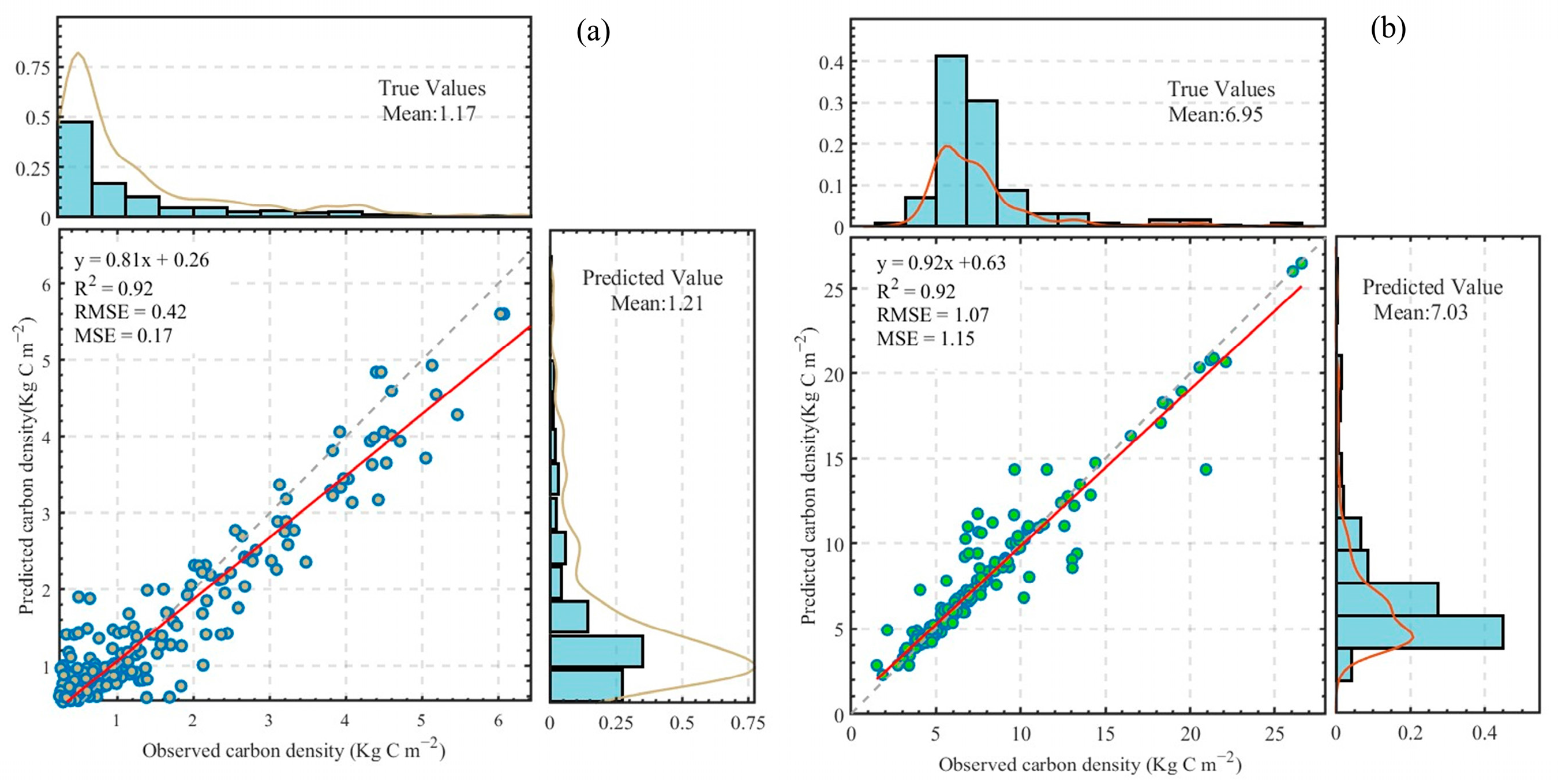
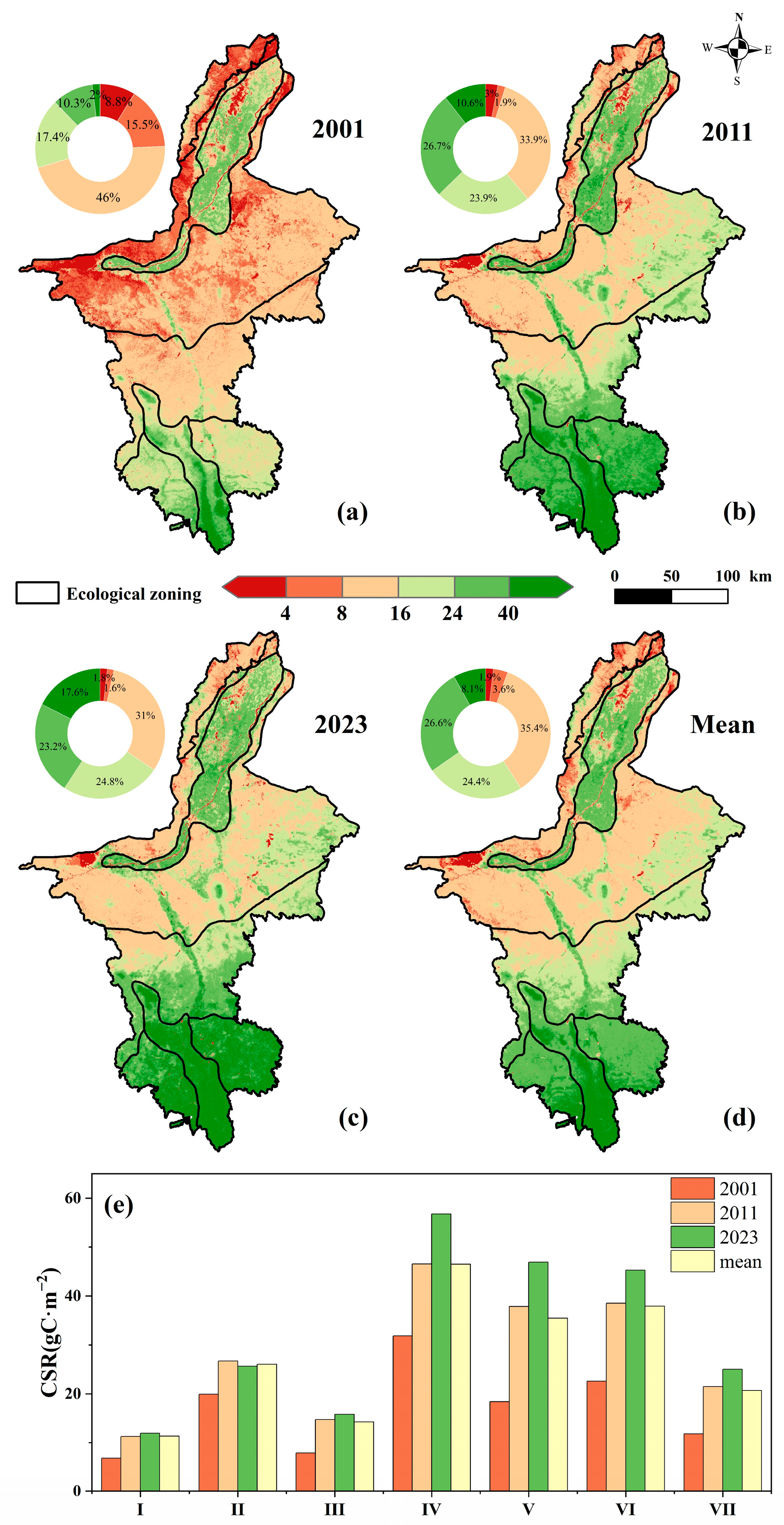
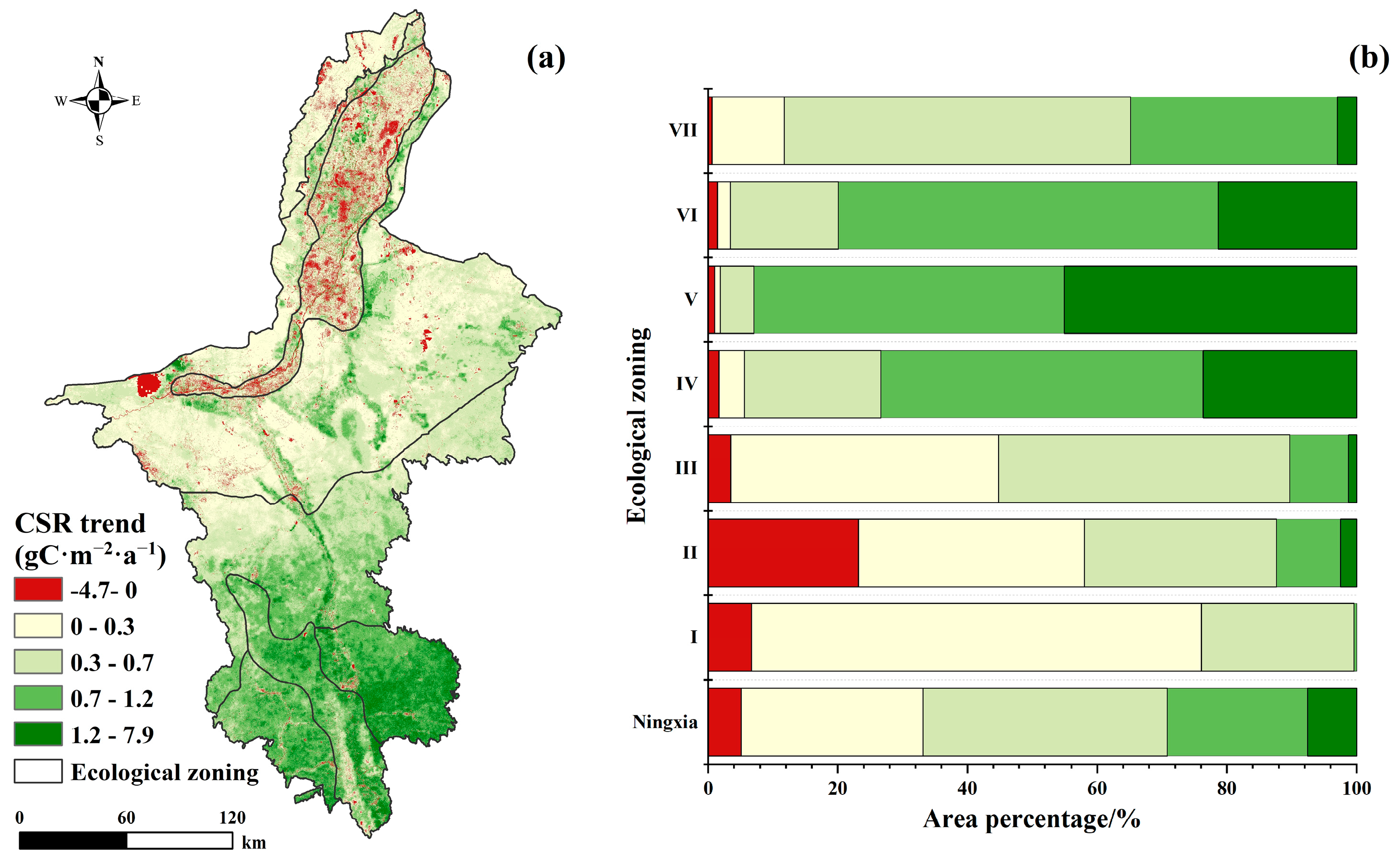

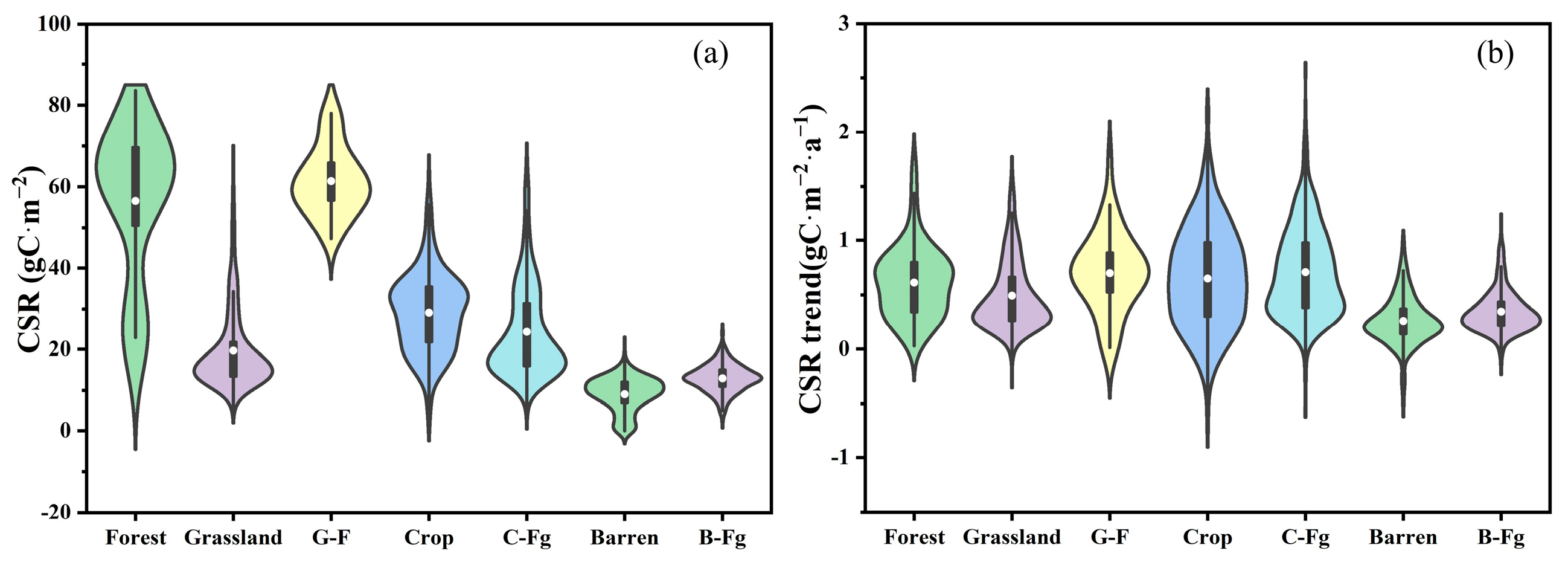

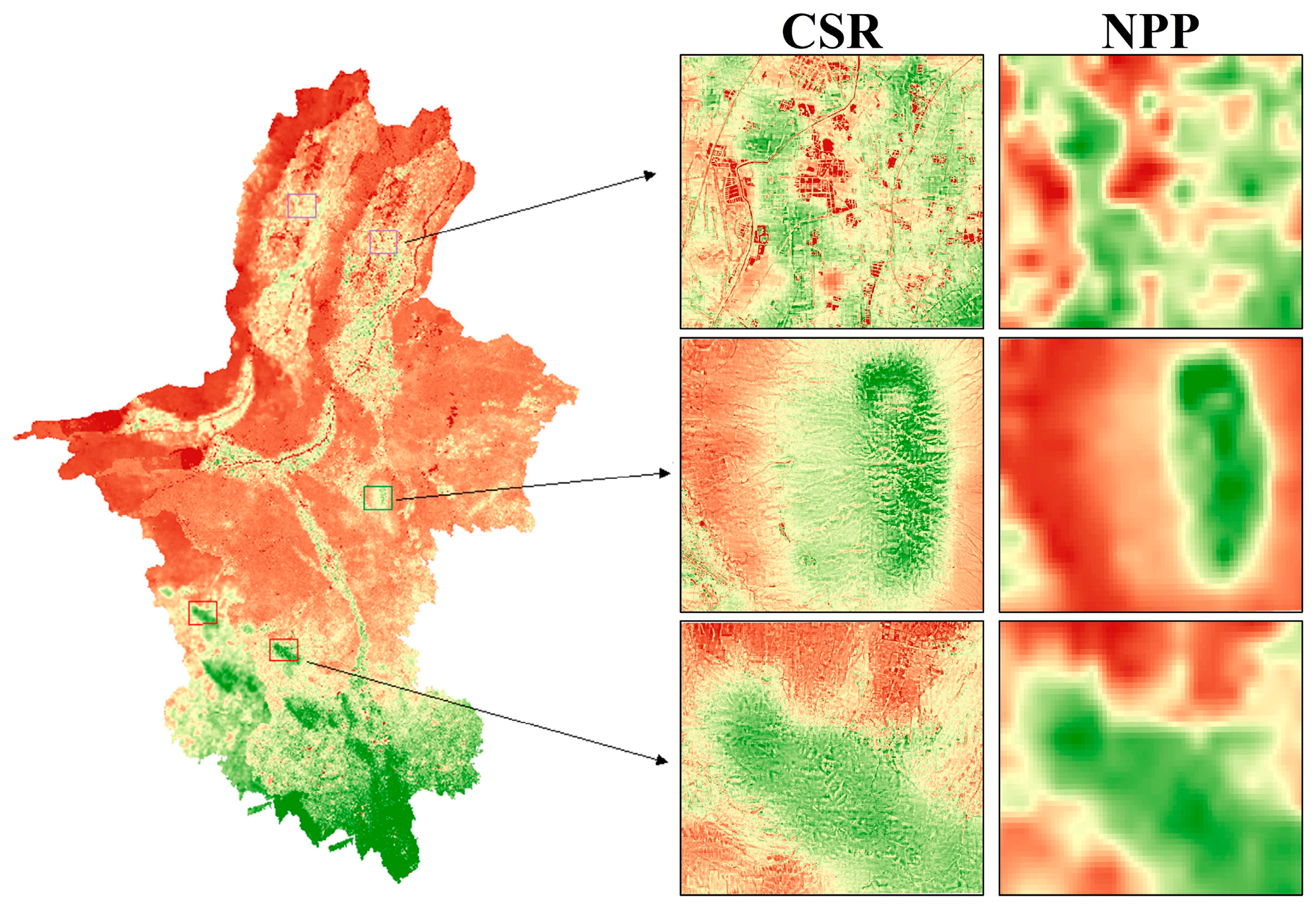
| Data Subcategory | Data Name | Product | Spatial Resolution | Temporal Duration |
|---|---|---|---|---|
| Topography | DEM | AW3D30 | 30 m | 2010 |
| Slope | - | 30 m | 2010 | |
| Aspect | - | 30 m | 2010 | |
| Terrace | TDMLP | 1.89 m | 2021 | |
| LS | - | 30 m | 2010 | |
| Topographic index | - | 30 m | 2010 | |
| Climate | Precipitation | NCEP | 0.25° | 2000–2023 |
| Temperature | ERA5 | 0.25° | 2000–2023 | |
| Vegetation index | Surface reflectance | Landsat SR | 30 m | 2000–2023 |
| NDVI | - | 30 m | 2000–2023 | |
| EVI | - | 30 m | 2000–2023 | |
| NDMI | - | 30 m | 2000–2023 | |
| RVI | - | 30 m | 2000–2023 | |
| Soil properties | Bulk density | SoilGrids | 250 m | 2021 |
| Clay content | SoilGrids | 250 m | 2021 | |
| Sand | SoilGrids | 250 m | 2021 | |
| Slit | SoilGrids | 250 m | 2021 |
| Land Use | CSR/gC·m−2 | Carbon Sink /Gg C | CSR Trend /gC·m−2·a−1 | CSR Trend /Gg C·a−1 | Enhancement Contribution Rate/% |
|---|---|---|---|---|---|
| Forest | 56.53 | 40.54 | 0.62 | 0.44 | 1.26% |
| Grassland | 19.70 | 368.49 | 0.49 | 9.17 | 26.04% |
| Crop | 29.08 | 622.91 | 0.65 | 13.92 | 39.56% |
| Barren | 9.09 | 43.03 | 0.26 | 1.23 | 3.50% |
| G-F | 61.40 | 40.77 | 0.70 | 0.46 | 1.32% |
| C-Fg | 24.34 | 221.09 | 0.71 | 6.45 | 18.32% |
| B-Fg | 12.93 | 138.66 | 0.35 | 3.75 | 10.66% |
Disclaimer/Publisher’s Note: The statements, opinions and data contained in all publications are solely those of the individual author(s) and contributor(s) and not of MDPI and/or the editor(s). MDPI and/or the editor(s) disclaim responsibility for any injury to people or property resulting from any ideas, methods, instructions or products referred to in the content. |
© 2025 by the authors. Licensee MDPI, Basel, Switzerland. This article is an open access article distributed under the terms and conditions of the Creative Commons Attribution (CC BY) license (https://creativecommons.org/licenses/by/4.0/).
Share and Cite
Zhang, Y.; Cheng, C.; Wang, Z.; Hai, H.; Miao, L. Spatiotemporal Variation and Driving Factors of Carbon Sequestration Rate in Terrestrial Ecosystems of Ningxia, China. Land 2025, 14, 94. https://doi.org/10.3390/land14010094
Zhang Y, Cheng C, Wang Z, Hai H, Miao L. Spatiotemporal Variation and Driving Factors of Carbon Sequestration Rate in Terrestrial Ecosystems of Ningxia, China. Land. 2025; 14(1):94. https://doi.org/10.3390/land14010094
Chicago/Turabian StyleZhang, Yi, Chunxiao Cheng, Zhihui Wang, Hongxin Hai, and Lulu Miao. 2025. "Spatiotemporal Variation and Driving Factors of Carbon Sequestration Rate in Terrestrial Ecosystems of Ningxia, China" Land 14, no. 1: 94. https://doi.org/10.3390/land14010094
APA StyleZhang, Y., Cheng, C., Wang, Z., Hai, H., & Miao, L. (2025). Spatiotemporal Variation and Driving Factors of Carbon Sequestration Rate in Terrestrial Ecosystems of Ningxia, China. Land, 14(1), 94. https://doi.org/10.3390/land14010094










